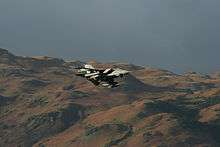Low flying military training


Low flying military training involves military aircraft flying at low altitude to prepare their aircrew, and other military personnel (e.g. air defence troops), for nap-of-the-earth flying in wartime. The aircraft types can include advanced trainers, ground-attack aircraft, transports and helicopters.
Some countries have sufficiently large military reservations for such training to take place without affecting the civilian population. In smaller countries, such as in Europe, there can be tension between the military and the local population - mainly because of aircraft noise.
Hazards
Low-level flying involves air safety hazards such as:
- Collision with the ground, electricity wires etc. as a result of pilot error (e.g. Cavalese, 1998) or failure of aircraft systems - at low level and high speed there is little time to react to any problem.
- Mid-air collision with light aircraft (e.g. Norfolk, 1974) or other military aircraft.
- Bird strike.
The noise can also disturb animals and hence cause a hazard to horse-riders etc.[Note 1]
By country
United Kingdom

In the UK, low flying means fixed-wing aircraft at less than 2000 feet from the ground or light propeller driven aircraft and helicopters below 500 feet from the ground.[2]
Low flying is permitted across the majority of the UK except for large urban areas, civil airports and some industrial and medical sites. Fixed-wing aircraft can fly down to 250 ft above ground level at a speed of up to 450 kt. Lower height limits apply for helicopters and in certain parts of mid Wales, Northern England and Northern Scotland, designated Tactical Training Areas.[3]
For safety and to minimise disturbance to the public, military aircrew training at low level is constrained by rules. A specialist military police unit conducts covert monitoring using mobile radar and investigates alleged infringements.[4]
See also
- Ground Proximity Warning System (GPWS)
- Controlled flight into terrain
- Lists of accidents and incidents involving military aircraft
- Military operations area
- Military training route
Notes
- ↑ On 10 June 2003 a RAF Chinook HC2 pilot flew low over horseriders in rural Lincolnshire. This caused one horse to behave uncontrollably and resulted in the death of the rider. At a subsequent inquest, the death was blamed upon the actions of the pilot while operating under inappropriate low flying rules from the UK Ministry Of Defence. The UK MOD undertook a review of their policies and raised the minimum flight height as a result.[1]
References
- ↑ http://news.bbc.co.uk/2/hi/uk_news/england/lincolnshire/3958685.stm
- ↑ http://www.mod.uk/DefenceInternet/AboutDefence/WhatWeDo/AirSafetyandAviation/LowFlying (accessed 11 December 2011)
- ↑ http://www.mod.uk/NR/rdonlyres/22A9CEDC-4069-4E68-AE77-15317255935B/0/UK_Military_Low_Flying.pdf page 7 (accessed 11 December 2011)
- ↑ http://www.mod.uk/NR/rdonlyres/22A9CEDC-4069-4E68-AE77-15317255935B/0/UK_Military_Low_Flying.pdf page 10 (accessed 11 December 2011)